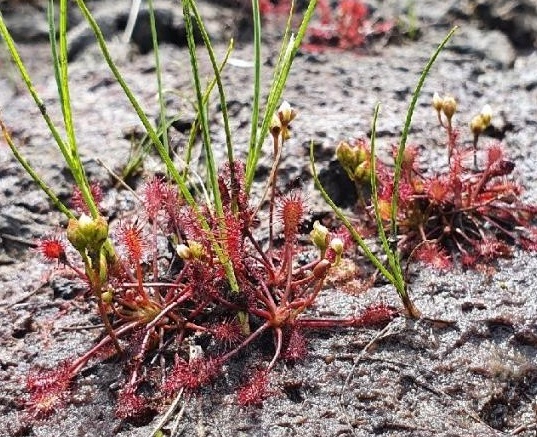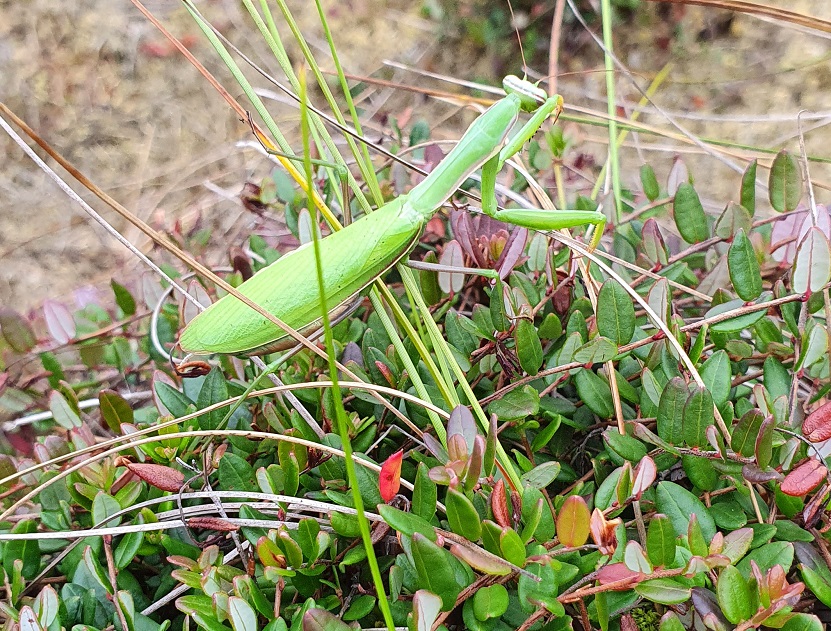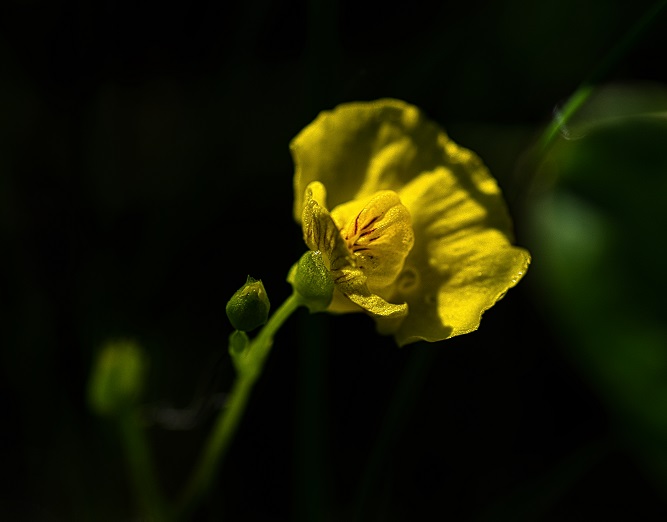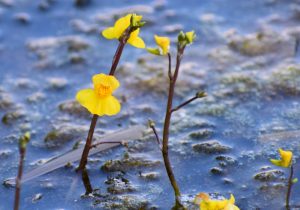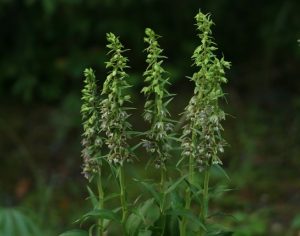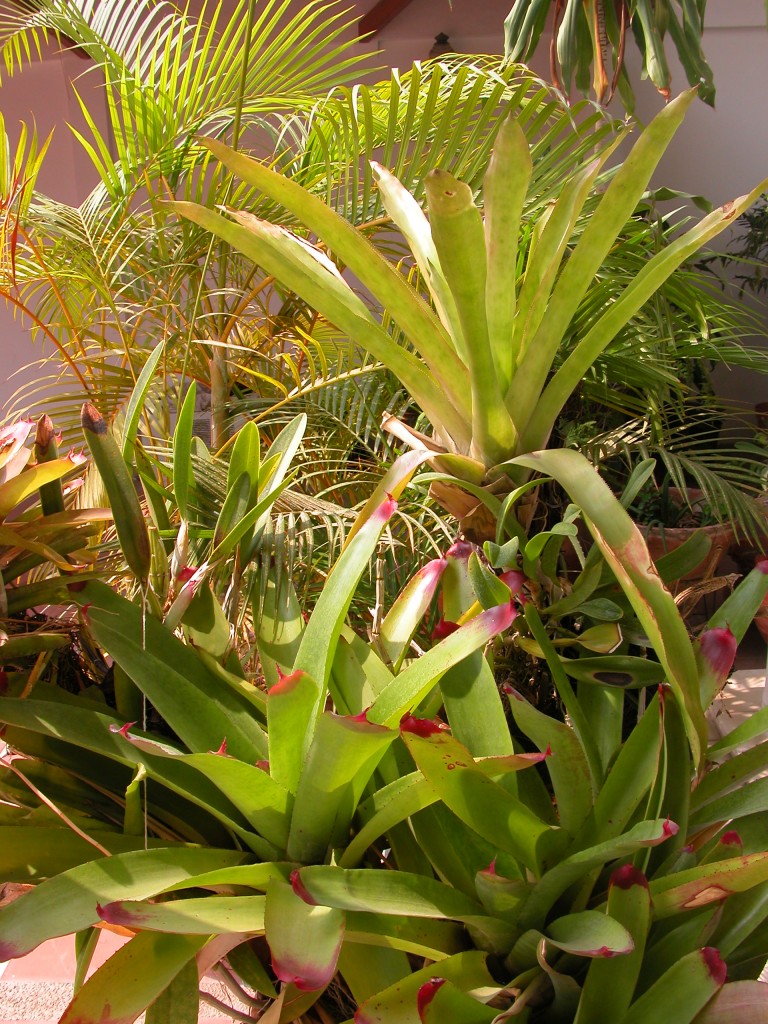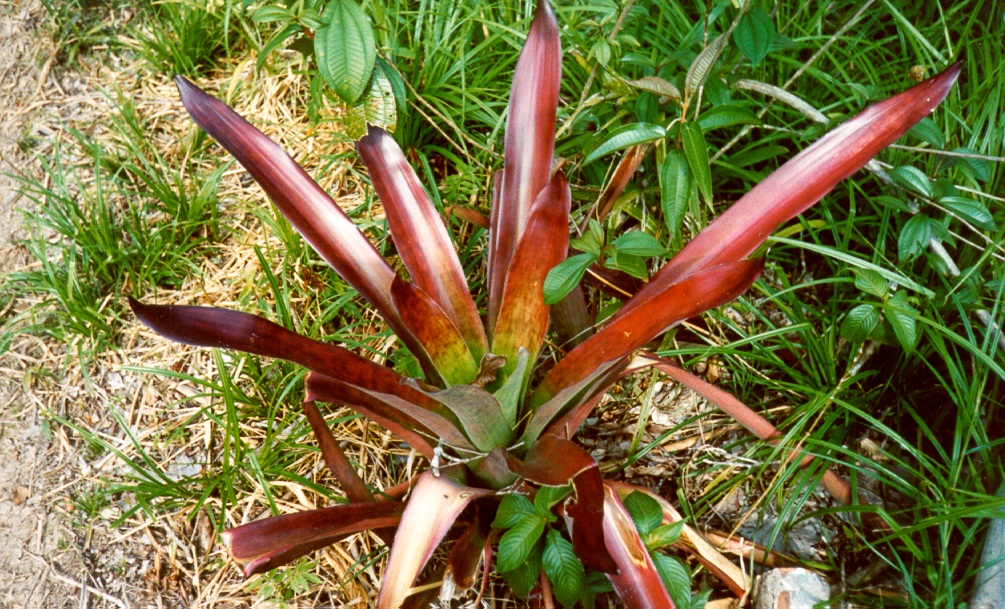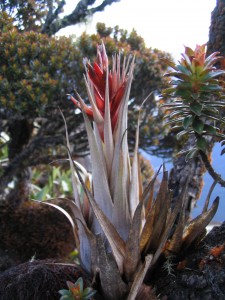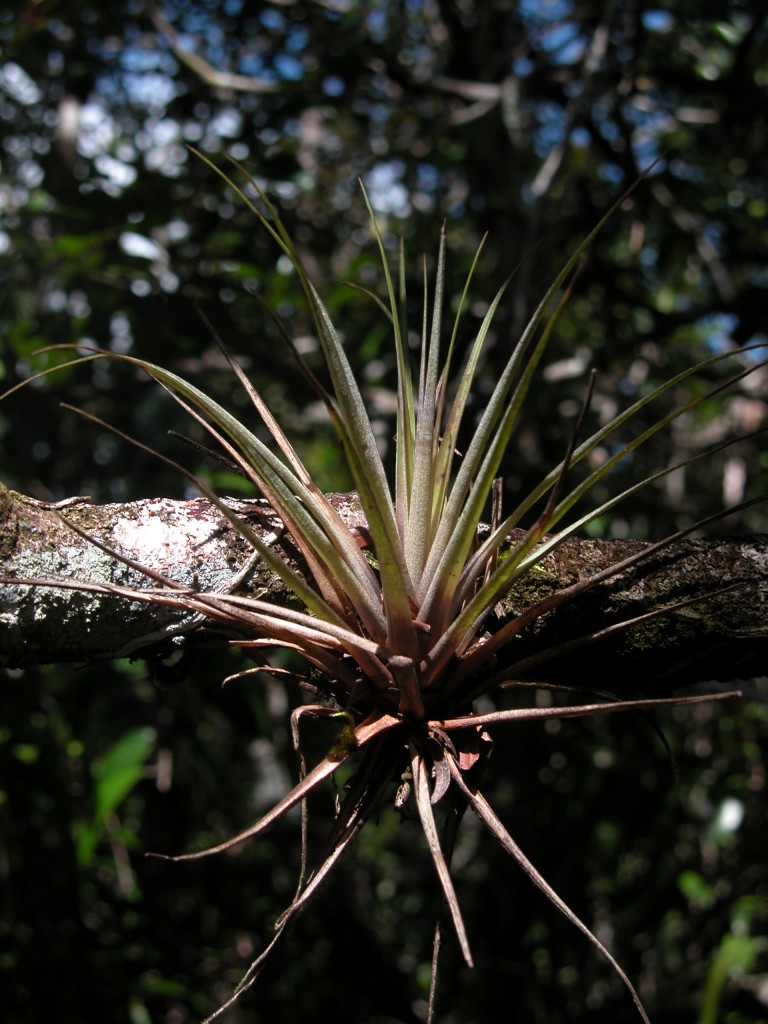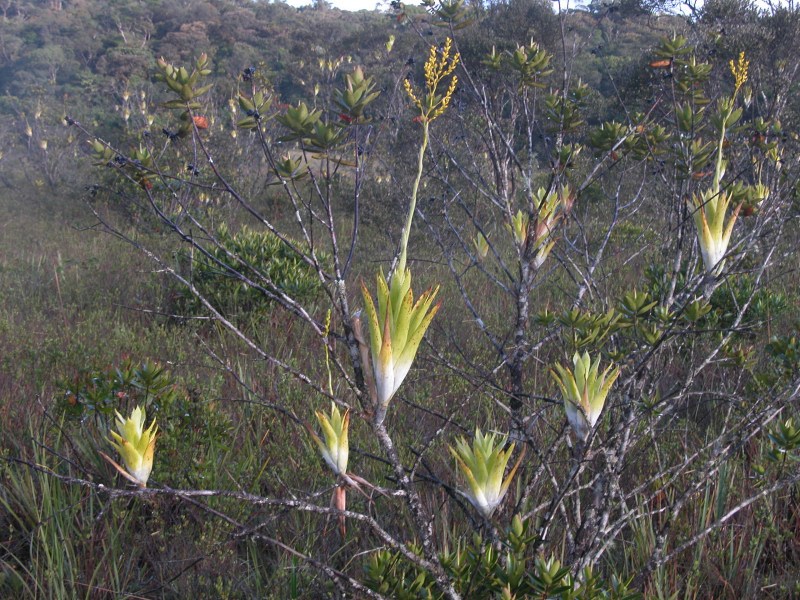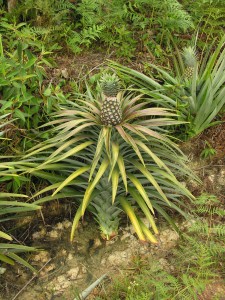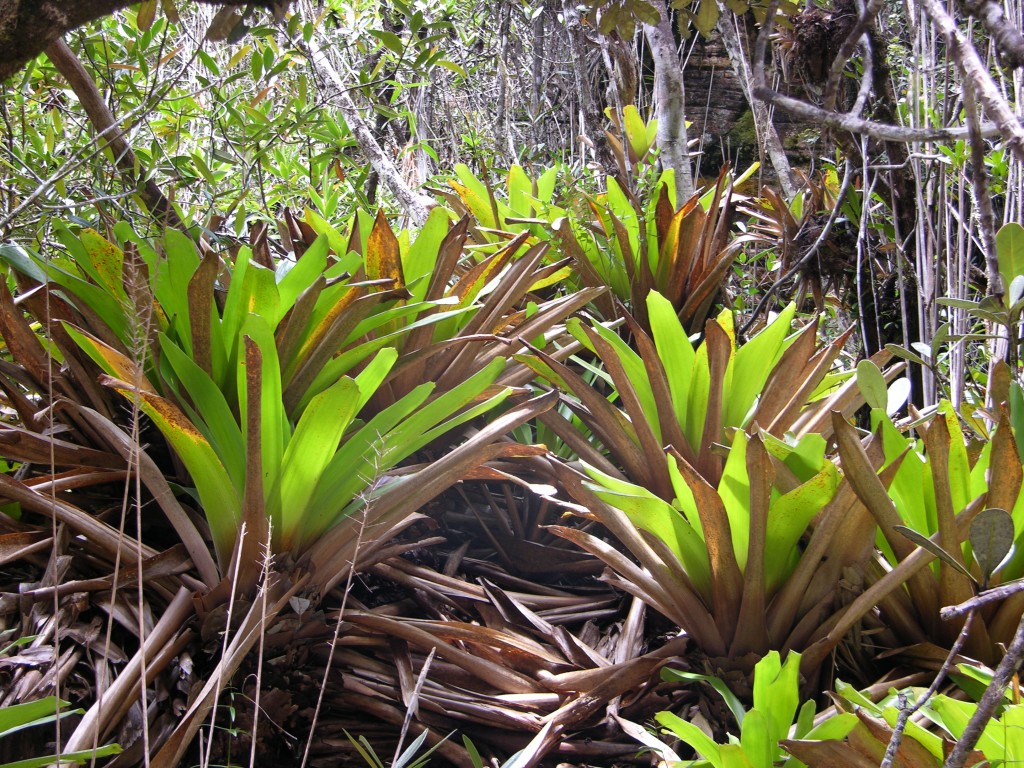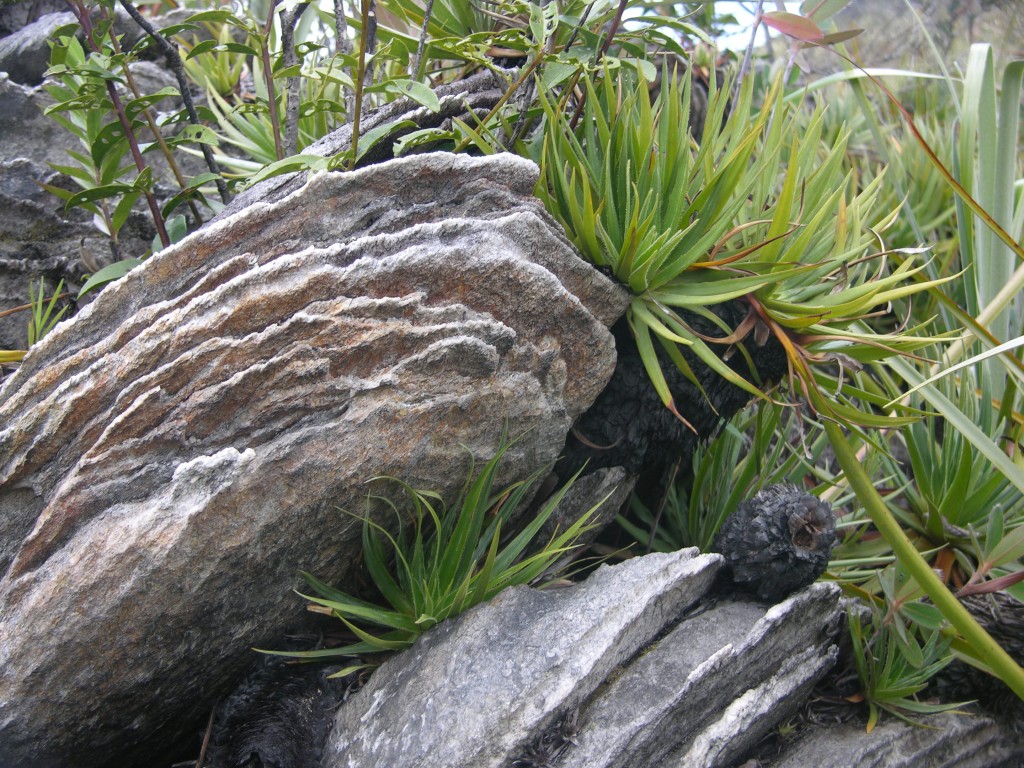![]() .
.
The bromeliads are a diverse family of flowering plants that originate from mainly tropical and subtropical latitudes of the Americas and in the case of just one exceptional species, also Western Africa. Approximately 2,400 species of bromeliads belonging to 59 genera are currently recognized, which represents a spectacular diversity of plants, including terrestrial, epiphytic and lithophytic species. The diversity of the growing habits of species of bromeliads has enabled this family to become extremely successful across the American continents and bromeliads are found almost without interruption from the southern states of the USA to the central Argentina and Chile. Across this wide geographic range, species of bromeliads have evolved to inhabit a wide spectrum of habitats ranging from rain forests, cloud forests, lowland hot deserts to highland alpine environments and are found from 0 to at least 4,200 meters above sea level.
The foliage of bromeliads is generally arranged in a compact rosette consisting of a variable number of leaves. Each individual leaf varies in shape and colour between species, while many bromeliads produce broad, expansive leaves, other species produce narrow, linear leaves. In some cases, the foliage may be just a few centimeters long (for example species of Tillandsia), whereas in other cases, the leaves may exceed one meter in length (for example species of Brocchinia). In most cases, the leaf rosette grows upright on a short, sometimes woody stem and in the case of some genera of bromeliads, the foliage is lined with modified hair-like structures called trichomes which enable A colourful leaves bromeliad species growing wild in Belize, Central America absorption of water and nutrients directly into the leaves. The foliage of many genera of bromeliad can be extremely colourful and highly patterned, bearing spectacular displays or red, maroon, gold, yellow, black or green.
The flowers of bromeliads vary profoundly between the fifty nine different genera however in most cases, multiple flowers are born from large, usually conspicuously coloured flower spikes, which can consist of up to 500 individual flower structures. In most cases, the individual flowers open in succession over the course of several weeks, starting with flowers towards the base of the inflorescence.
Generally, each flower remains open for 1–4 days, however in some species each flower may open for just a few hours. In the species of bromeliads which produce the largest inflorescences, the flower spike may last several months before all of the flowers open. The largest species of all bromeliads is Puya raimondii which also produces the largest inflorescence which can exceed seven meters in length. The flowers of bromeliads are often extremely colourful and showy and in a few cases, they can bear scents and fragrances. In most cases, a bromeliad plant dies back shortly after flowering finishes, but in most species, this encourages offshoots to be produced so that individual bromeliads rapidly form dense clumps of plants.
Approximately half the known species of bromeliads are epiphytes, growing on the branches of trees. As true epiphytes, epiphytic bromeliad plants grow independently from the ground and so have evolved a number of specialized adaptations in order to acquire water and nutrients independently from the substrate. The foliage of many genera of epiphytic bromeliads (for example Tillandia) is broad and forms an effective trap for rain and falling leaves and organic matter. Indeed many bromeliads – the so called tank bromeliads – produce foliage that collectively forms a hollow, water containing vessel in which rain water and debris collects. The accumulation of rain and debris provides a source of water and nutrients which the bromeliads can absorb directly into their leaves by means of the trichomes which line the surface of the plants leaves.
The roots of most epiphytic bromeliads are generally reduced in function and serve mainly to anchor the plant in to the branches of its host tree. Growing on the branches of trees renders bromeliad plants vulnerable to severe drought. Despite the high rates of precipitation, the intense equatorial sunlight dissipates all moisture very rapidly, so the epiphytic bromeliads have evolved several xerophytic adaptations in many ways similar to those of desert plants. The leaves and stem of many epiphytic bromeliads species are thick and fleshy (for example in Tillandsia species) and readily store water. The exposed surface of the leaves is lined with relatively few pores and a waxy epidermis which minimizes water loss.
One of the most diverse and spectacular groups of epiphytic bromeliads are the air plants of the genus Tillandsia. The air plants are particularly common growing on the branches of rainforest and cloud forest across tropical regions of the Americas and have evolved to acquire nutrients from dust, decaying leaves and insect matter particularly efficiently. The leaves of Tillandsia are lined particularly heavily with trichomes to the extent that in many species the foliage appears grayish.
Three species of tank bromeliads of South America of the genera Catopsis and Brocchinia have taken the adaptations of the epiphytic bromeliads one step further and have evolved to actively attract and catch insect prey. The foliage of these plants is baited with lures of sweet scent and vivid colouration, which attracts insects. The surface of the leaves is extremely waxy and lined with a crumbly white powder and eventually the visiting insects slip and falls into the water filled leaf axils within the plants’ rosette where, unable to scale the slippery interior surface of the trap, the trapped prey dies and is digested to release nutrients that the bromeliad absorbs.
It is difficult to fully appreciate the diversity and number of epiphytic bromeliads in their natural habitat, since, growing in the forest canopy up to 100 meters above the ground the epiphytic bromeliads are often difficult to observe closely. In the rainforests of South America and Central America, the great tropical trees are often festooned with thousands of individual bromeliad plants which form a major component of the epiphytic rainforest biome as the home of amphibians, insects and other animals. Eventually, the weight of the epiphytic plants causes the branches of the rainforest trees to break, and fall to the ground. Fallen branches of the rainforest trees often still hold epiphytic bromeliads intact, so that some species can continue to grow on the dead branches of their host trees, resting on the ground.
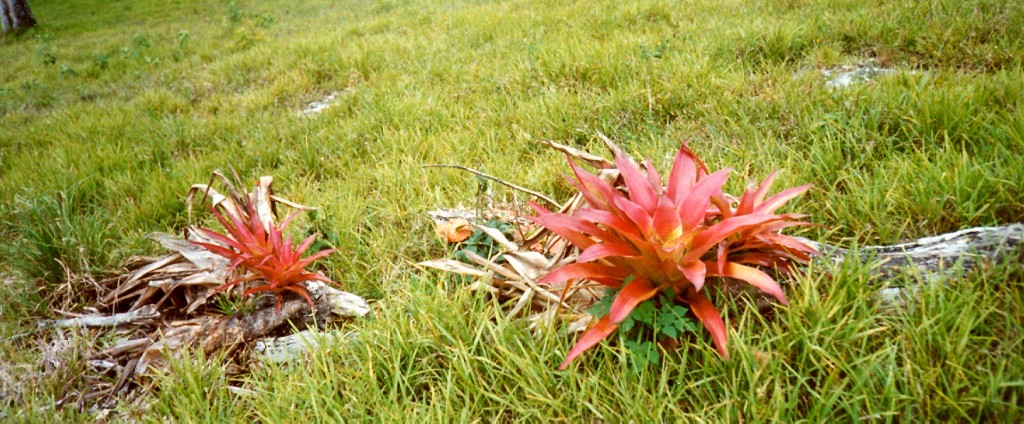
Various epiphytic bromeliads growing on a fallen branch of a great tropical hardwood tree in Belize, Central America
Other genera of bromeliads such as Navia and Brocchinia have specialized to grow as terrestrial plants which offers the advantage that the plants roots can uptake nutrients and water from the substrate. With this ability, the terrestrial bromeliads have evolved to include the largest species of all bromeliads, Brocchinia tatei is a particularly large species growing across Southern Venezuela and neighbouring Guyana and Brazil. It produces foliage that can exceed 120 cm in length and aged specimens can form woody trunks up to 1 meters tall. However the very largest of all species of bromeliads Puya raimondii from Peru and Bolivia produces gigantic foliage up to four meters in length.
Of the great diversity of bromeliads, only one species produces a fruit that is edible by man and is commercially exploited, this plant being the pineapple, Ananas comosus. The pineapple plant is a terrestrial bromeliad that is native to Uruguay, Brazil, Puerto Rico and Paraguay however had been widely distributed through cultivation through the Americas and the Caribbean by the time Christopher Columbus arrived in the New World (1492).
Various Amerindian groups of Central America and South America used pineapples as a mainstay crop for thousands of years prior to the arrival of Europeans in the New World. The Aztecs, Incas and Maya have been widely documented to have used the fruit and the leaves of the pineapple plant fibres and indeed this use continues today. Indeed the appeal of cultivating bromeliads is such that as early as 1776 various species of bromeliads were brought to Europe to be cultivated and sold through early horticultural nurseries. Guzmania lingulata was famously released in 1776 and caused fascination among horticulturalists. Similarly, Aechmea fasciata and Vriesea splendens were also successfully introduced into cultivation in Europe during the early 19th century and remain widely cultivated still today. During the intervening two hundred years, the popularity of the cultivation of bromeliads has grown steadily and many thousands of spectacular hybrids and cultivars have since been produced. As the exploration of the enduring remote areas of South America continues, new species of bromeliads are continually being discovered and at the start of the 21st century it is clear that we are still only beginning to understand the full diversity of this remarkable and spectacular group of plants.
The Bromeliad Society International provides an excellent resource for purchasing bromeliads and joining bromeliad societies across the world, please see http://www.bsi.org for more details.
Stewart McPherson
